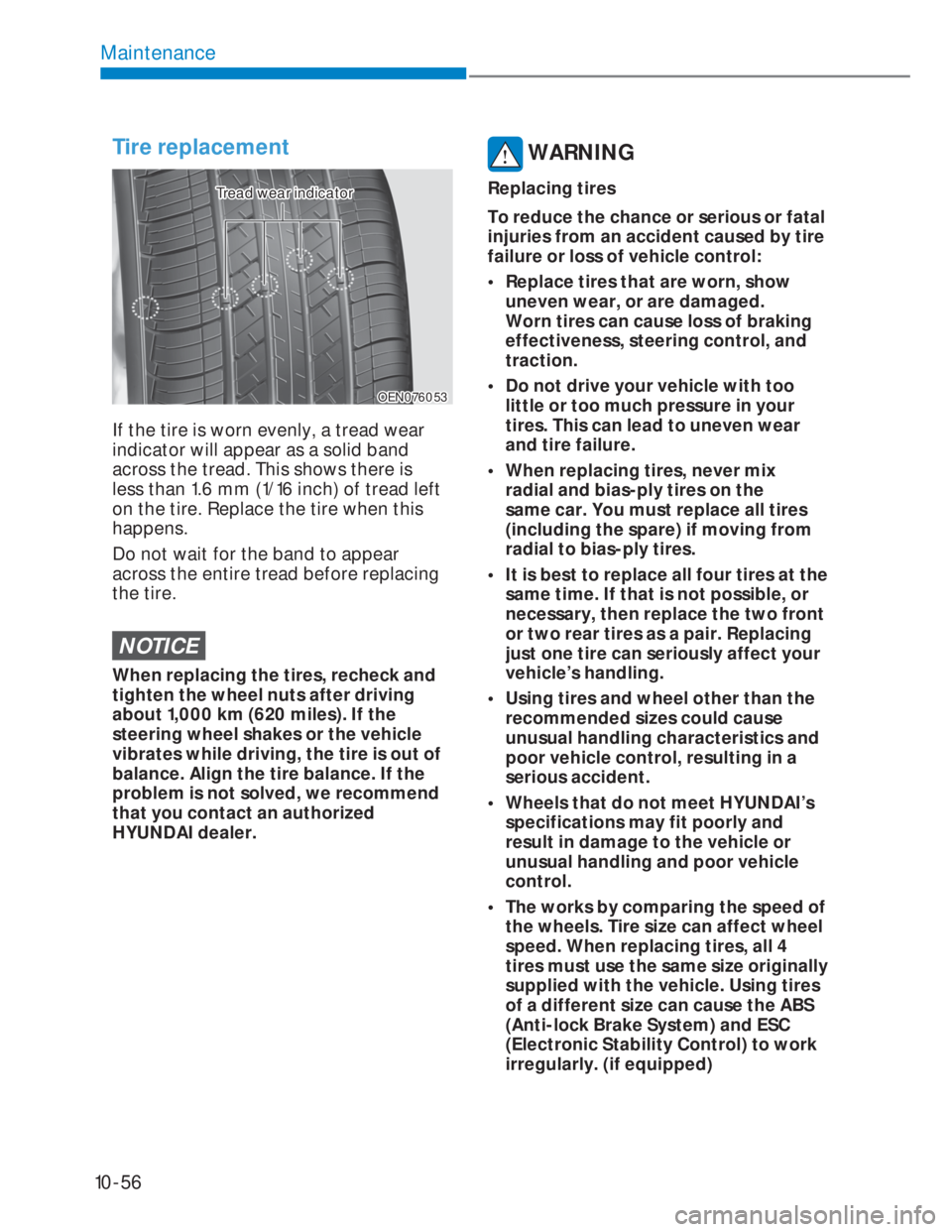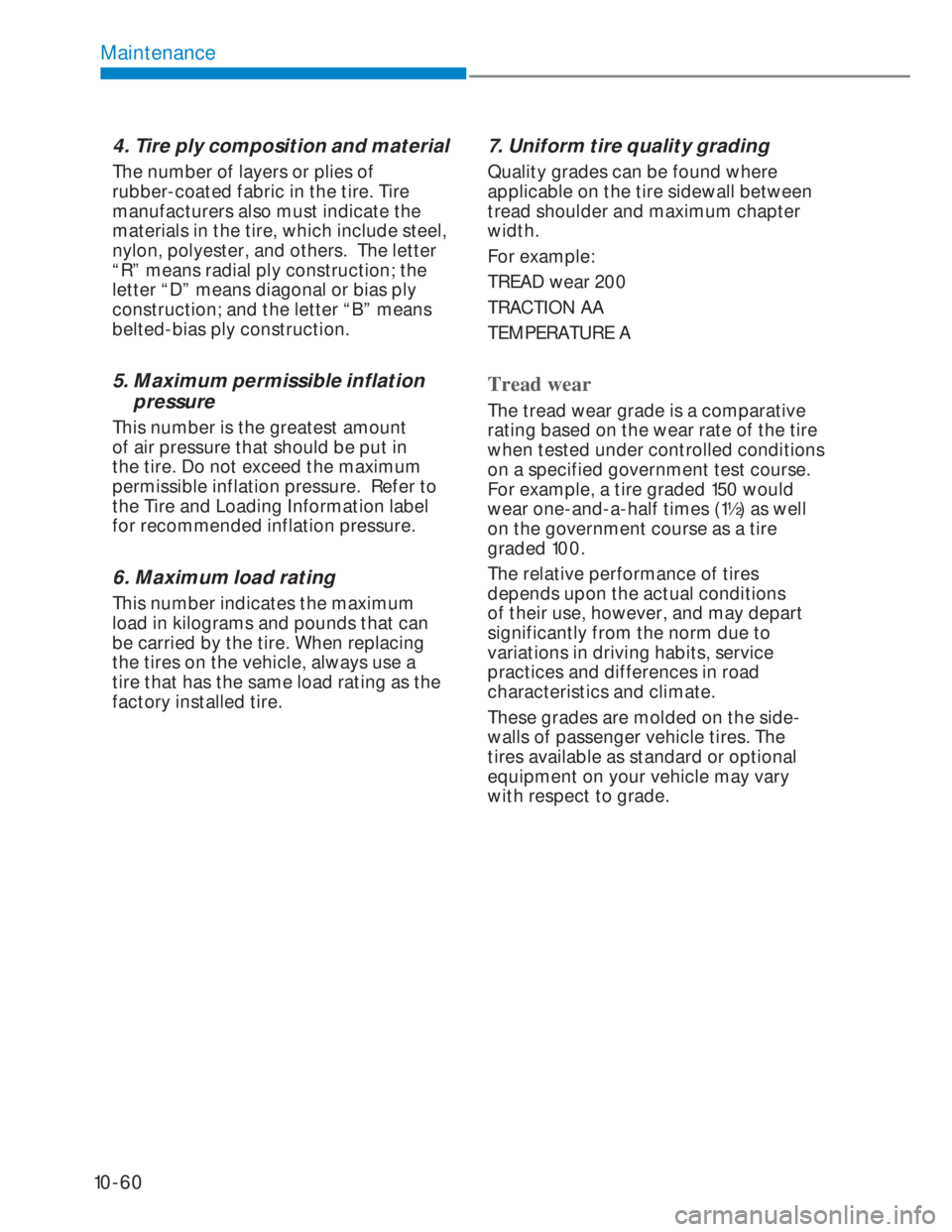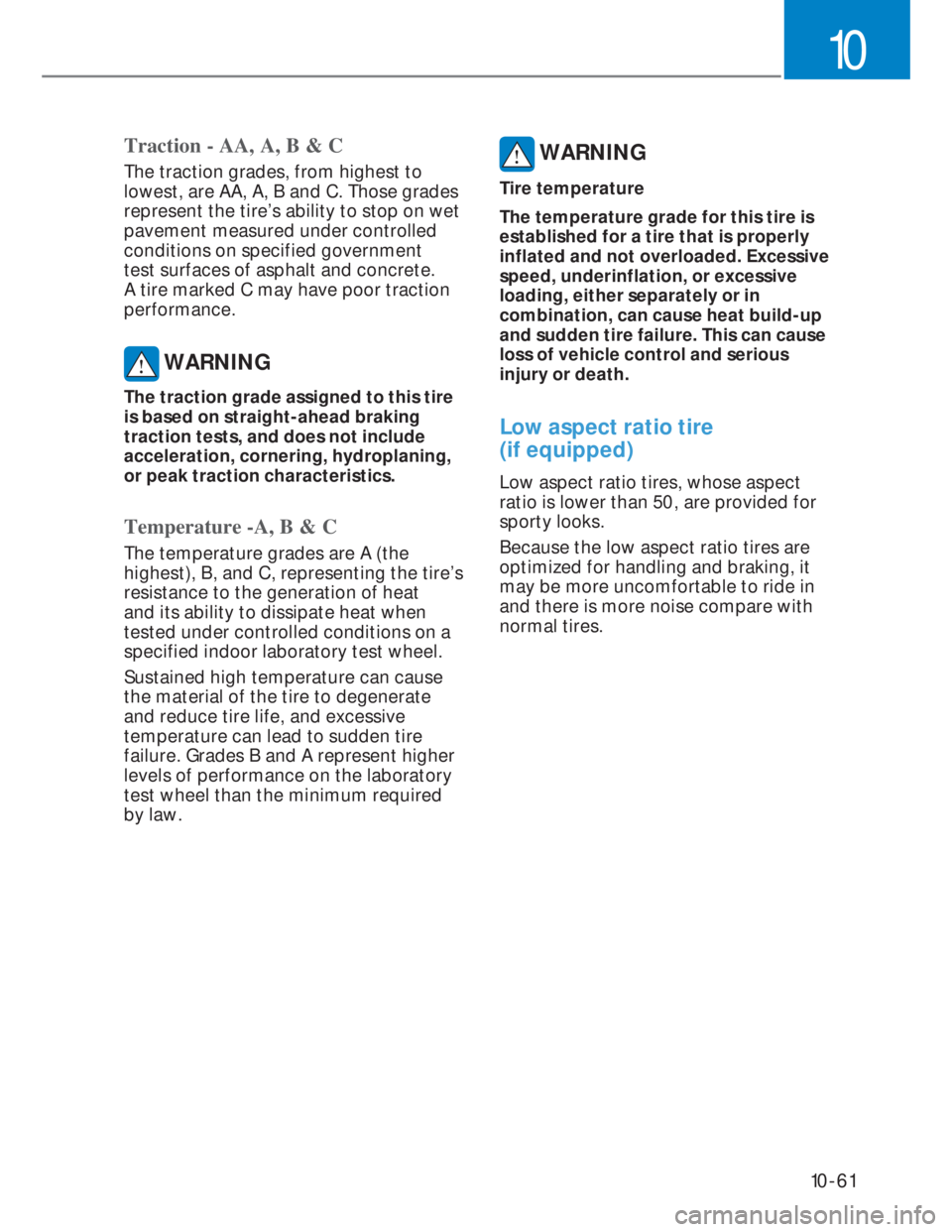Page 291 of 444

7-44
Driving your vehicle
ESC OFF usage
When Driving
The ESC OFF mode should only be used
briefly to help free the vehicle if stuck in
snow or mud, by temporarily stopping
operation of the ESC, to maintain wheel
torque.
To turn ESC off while driving, press the
ESC OFF button while driving on a flat
road surface.
NOTICE
To prevent damage to the transmission:
• Do not allow wheel(s) of one axle to
spin excessively while the ESC, ABS,
and parking brake warning lights
are displayed. The repairs would not
be covered by the vehicle warranty.
Reduce engine power and do not spin
the wheel(s) excessively while these
lights are displayed.
• When operating the vehicle on
a dynamometer, make sure the
ESC is turned off (ESC OFF light
illuminated).
i Information
Turning the ESC off does not affect ABS
or standard brake system operation.
Vehicle Stability Management
(VSM) (if equipped)
The Vehicle Stability Management (VSM)
is a function of the Electronic Stability
Control (ESC) system. It helps ensure the
vehicle stays stable when accelerating
or braking suddenly on wet, slippery and
rough roads where traction over the four
tires can suddenly become uneven.
WARNING
Take the following precautions when
using the Vehicle Stability Management
(VSM):
• ALWAYS check the speed and the
distance to the vehicle ahead. The
VSM is not a substitute for safe
driving practices.
• Never drive too fast for the road
conditions. The VSM system will not
prevent accidents. Excessive speed
in bad weather, slippery and uneven
roads can result in severe accidents.
Page 395 of 444

10-56
Maintenance
Tire replacement
OEN076053OEN076053
Tread wear indicatorTread wear indicator
If the tire is worn evenly, a tread wear
indicator will appear as a solid band
across the tread. This shows there is
less than 1.6 mm (1/16 inch) of tread left
on the tire. Replace the tire when this
happens.
Do not wait for the band to appear
across the entire tread before replacing
the tire.
NOTICE
When replacing the tires, recheck and
tighten the wheel nuts after driving
about 1,000 km (620 miles). If the
steering wheel shakes or the vehicle
vibrates while driving, the tire is out of
balance. Align the tire balance. If the
problem is not solved, we recommend
that you contact an authorized
HYUNDAI dealer.
WARNING
Replacing tires
To reduce the chance or serious or fatal
injuries from an accident caused by tire
failure or loss of vehicle control:
• Replace tires that are worn, show
uneven wear, or are damaged.
Worn tires can cause loss of braking
effectiveness, steering control, and
traction.
• Do not drive your vehicle with too
little or too much pressure in your
tires. This can lead to uneven wear
and tire failure.
• When replacing tires, never mix
radial and bias-ply tires on the
same car. You must replace all tires
(including the spare) if moving from
radial to bias-ply tires.
• It is best to replace all four tires at the
same time. If that is not possible, or
necessary, then replace the two front
or two rear tires as a pair. Replacing
just one tire can seriously affect your
vehicle’s handling.
• Using tires and wheel other than the
recommended sizes could cause
unusual handling characteristics and
poor vehicle control, resulting in a
serious accident.
• Wheels that do not meet HYUNDAI’s
specifications may fit poorly and
result in damage to the vehicle or
unusual handling and poor vehicle
control.
• The works by comparing the speed of
the wheels. Tire size can affect wheel
speed. When replacing tires, all 4
tires must use the same size originally
supplied with the vehicle. Using tires
of a different size can cause the ABS
(Anti-lock Brake System) and ESC
(Electronic Stability Control) to work
irregularly. (if equipped)
Page 396 of 444

10-57
10
Compact spare tire replacement
(if equipped)
A compact spare tire has a shorter tread
life than a regular size tire. Replace
it when you can see the tread wear
indicator bars on the tire. The replaced
compact spare tire should be the same
size and design tire as the one provided
with your new vehicle and should be
mounted on the same compact spare
tire wheel. The compact spare tire is not
designed to be mounted on a regular
size wheel, and the compact spare tire
wheel is not designed to mount a regular
size tire.
Wheel replacement
When replacing the metal wheels for any
reason, make sure the new wheels are
equivalent to the original factory units in
diameter, rim width and offset.
WARNING
A wheel that is not the correct size may
adversely affect wheel and bearing life,
braking and stopping abilities, handling
characteristics, ground clearance,
body-to-tire clearance, snow chain
clearance, speedometer and odometer
calibration, headlight aim and bumper
height.
Tire traction
Tire traction can be reduced if you drive
on worn tires, tires that are improperly
inflated or on slippery road surfaces.
Tires should be replaced when tread
wear indicators appear. Slow down
whenever there is rain, snow or ice on
the road, to reduce the possibility of
losing control of the vehicle.
Page 399 of 444

10-60
Maintenance
4. Tire ply composition and material
The number of layers or plies of
rubber-coated fabric in the tire. Tire
manufacturers also must indicate the
materials in the tire, which include steel,
nylon, polyester, and others. The letter
“R” means radial ply construction; the
letter “D” means diagonal or bias ply
construction; and the letter “B” means
belted-bias ply construction.
5. Maximum permissible inflation
pressure
This number is the greatest amount
of air pressure that should be put in
the tire. Do not exceed the maximum
permissible inflation pressure. Refer to
the Tire and Loading Information label
for recommended inflation pressure.
6. Maximum load rating
This number indicates the maximum
load in kilograms and pounds that can
be carried by the tire. When replacing
the tires on the vehicle, always use a
tire that has the same load rating as the
factory installed tire.
7. Uniform tire quality grading
Quality grades can be found where
applicable on the tire sidewall between
tread shoulder and maximum chapter
width.
For example:
TREAD wear 200
TRACTION AA
TEMPERATURE A
Tread wear
The tread wear grade is a comparative
rating based on the wear rate of the tire
when tested under controlled conditions
on a specified government test course.
For example, a tire graded 150 would
wear one-and-a-half times (1½) as well
on the government course as a tire
graded 100.
The relative performance of tires
depends upon the actual conditions
of their use, however, and may depart
significantly from the norm due to
variations in driving habits, service
practices and differences in road
characteristics and climate.
These grades are molded on the side-
walls of passenger vehicle tires. The
tires available as standard or optional
equipment on your vehicle may vary
with respect to grade.
Page 400 of 444

10-61
10
Traction - AA, A, B & C
The traction grades, from highest to
lowest, are AA, A, B and C. Those grades
represent the tire’s ability to stop on wet
pavement measured under controlled
conditions on specified government
test surfaces of asphalt and concrete.
A tire marked C may have poor traction
performance.
WARNING
The traction grade assigned to this tire
is based on straight-ahead braking
traction tests, and does not include
acceleration, cornering, hydroplaning,
or peak traction characteristics.
Temperature -A, B & C
The temperature grades are A (the
highest), B, and C, representing the tire’s
resistance to the generation of heat
and its ability to dissipate heat when
tested under controlled conditions on a
specified indoor laboratory test wheel.
Sustained high temperature can cause
the material of the tire to degenerate
and reduce tire life, and excessive
temperature can lead to sudden tire
failure. Grades B and A represent higher
levels of performance on the laboratory
test wheel than the minimum required
by law.
WARNING
Tire temperature
The temperature grade for this tire is
established for a tire that is properly
inflated and not overloaded. Excessive
speed, underinflation, or excessive
loading, either separately or in
combination, can cause heat build-up
and sudden tire failure. This can cause
loss of vehicle control and serious
injury or death.
Low aspect ratio tire
(if equipped)
Low aspect ratio tires, whose aspect
ratio is lower than 50, are provided for
sporty looks.
Because the low aspect ratio tires are
optimized for handling and braking, it
may be more uncomfortable to ride in
and there is more noise compare with
normal tires.